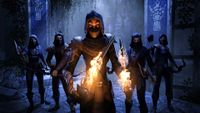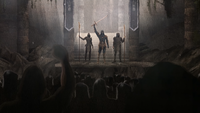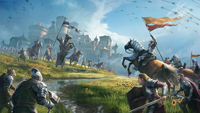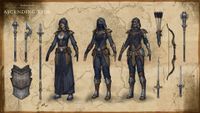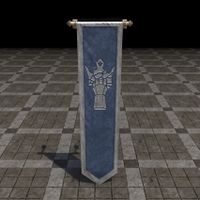Lore:Ascendant Order
The Ascendant Order was a pan-Tamrielic movement[UOL 1] turned terrorist organization that attempted to assassinate the major players responsible for the Three Banners War.[1] This war caused common folk across the continent whose lives were ruined by the destruction it caused to flock to the order.[2] They were drawn in by leaders of the faction, the Ascendant Lord and his Ascendant Magus, who promised them that they would bring down Tamriel's tyrants who grow richer and powerful at the expense of misery and bloodshed.[3] Breton-influenced, the Ascendant Order likened themselves to a Knightly Order, though most legitimate Orders thought of them as nothing more than well-armed fanatics.[UOL 1] Members of the organization concealed their identities and united under a share goal of toppling Tamriel's corrupt governments. They saw themselves not as bandits, but as knights that strike at tyranny from the shadows.[4] The Order had been generally non-hostile until the peace talks between the three alliances at High Isle, where they attempted to slay the faction leaders.[1] By this point, they had infiltrated nearly every level of Breton society,[5] and had established the Systres Archipelago as their main base of operations.[1]
History[edit]
The Ascendant Order was created by Lord Bacaro Volorus, who lost his partner and children during the conflict of the Colovian Revolt. He found some footing during his grief when he turned to philanthropy, and donated from his fortune to charities. He founded the Society of the Steadfast, a humanitarian organization as a response to the Three Banners War, which offered aid to the common folk affected by the continent-wide war.[6] In truth, Lord Bacaro had planned to leverage that goodwill he had built overtime to lure the major players responsible for the Three Banners War to their deaths.[citation needed]
Bacaro's identity as the Ascendant Lord was unmasked by The Vestige. His ultimate goal was to become the new Druid King and bring an era of destruction to Tamriel, replacing the fallen Empire with his own "Ivy Throne". The Vestige confronted him at Mount Firesong, defeating Volorus and saving the archipelago from destruction.[7][8]
Although the peace talks were initially a trap set by Lord Bacaro, the Steadfast Society were kept in the dark about his plans and had no involvement with the Ascendant Order. Even with Lord Bacaro gone, they continued his original vision of helping those suffering from war and disaster As Lord Bacaro had set up a trust many years ago, the society was self-sufficient, and they continued to sponsor the peace talks and take care of all the expenses.[9]
The significance of the Ascendant Order allowed them to be documented within the Infinite Archive in Apocrypha. There, copies of them were subsequently created as maligraphies, creatures composed of vivified ink manifested by stories from books, and serve as mindless extensions of the Daedric Lord Tho'at Replicanum.[10][11][12]
Alternative Fate[edit]
The Psijic Order had the means to scry secrets from fate lines beyond the bounds of Tamriel. Among these secrets were tomes that spoke of alternative timelines and realities, where certain key events transpired differently.[13] In one of these alternate realities, Bacaro defeated his other enemies and ruled over Tamriel from atop his Ivy Throne in Mount Firesong in a new druidic reign. With his victory, Tamriel was engulfed in firestorms targeting "false kings and queens", and those displaced by them were assisted by the Ascendant Order, Society of the Steadfast, and reformed Druids of Galen. Dark and cold days filled with turmoil were the norm during this transition, as volcanoes continued to "belch forth their retribution" covering the skies, but according to Bacaro's subordinates, the hardships would pass and the Ascendant Lord would uplift Tamriel's citizens.[14]
Gallery[edit]
See Also[edit]
- For game-specific information, see the Elder Scrolls Online article.
References[edit]
- ^ a b c Events of ESO
- ^ The Ascendant Proclamation
- ^ Meet the Character(s) - The Ascendant Lord and Magus — Adandora, Chronicler-at-Large
- ^ Crafting Motif 111: Ascendant Order Style — the Ascendant Champion
- ^ The Elder Scrolls Online: High Isle & Update 34 Now Live on All Platforms on the official ESO website
- ^ The Society of the Steadfast — Phrastus of Elinhir
- ^ Events of The Hidden Lord in ESO: High Isle
- ^ Events of The Ivy Throne in ESO: High Isle
- ^ Captain Marguerite's dialogue in ESO: High Isle
- ^ Loremaster's Archive - Infinite Archive — Master Malkhest
- ^ Master Malkhest's dialogue in ESO: Necrom
- ^ Enemies in Infinite Archive in ESO
- ^ Tracker of Temporal Tomes achievement description in ESO
- ^ Coral Aerie Temporal Tome — Varallion
Note: The following references are considered to be unofficial sources. They are included to round off this article and may not be authoritative or conclusive.
